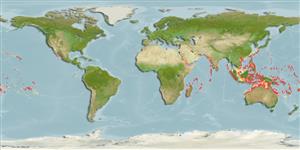Common names from other countries
>
Kurtiformes (Nurseryfishes, cardinalfishes.) >
Apogonidae (Cardinalfishes) > Apogoninae
Etymology: Apogonichthys: Greek, a = without + Greek pogon = chin, beard + Greek, ichthys = fish (Ref. 45335).
More on author: Bleeker.
Environment: milieu / climate zone / depth range / distribution range
Ecología
marino asociado a arrecife; rango de profundidad 1 - 65 m (Ref. 37816), usually 1 - 4 m (Ref. 90102). Tropical; 32°N - 28°S
Indo-Pacific: Red Sea south to Inhambane (Ref. 4329) and east to the Hawaiian Islands and Rapa, north to southern Japan; throughout Micronesia.
Tamaño / Peso / Age
Maturity: Lm ? range ? - ? cm
Max length : 6.0 cm TL macho / no sexado; (Ref. 90102); common length : 3.6 cm SL macho / no sexado; (Ref. 37816)
Espinas dorsales (total) : 8; Radios blandos dorsales (total) : 9; Espinas anales: 2; Radios blandos anales: 8. Olive brown with irregular dark spots and streaks; speckled fins; normally with a dark line from eye to origin of LL and stripe from eye to angle of preopercle (Ref. 4329, 48635). Developed gill rakers 5-7. A distinctive small white spot centrally at base of caudal fin (Ref. 48635).
Adults occur inshore (Ref. 7300). Found among rubble of reef flats and 'dead' reefs (Ref. 1602, 58302). Benthic and benthopelagic (Ref. 58302). Secretive (Ref. 48635), nocturnal species (Ref. 7300). Eggs are incubated orally (Ref. 205). Minimum depth reported taken from Ref. 57178.
Life cycle and mating behavior
Maturities | Reproducción | Spawnings | Egg(s) | Fecundities | Larva
Displays obligate monogamy where a one-to-one pair is established irrespective of resource abundance (Ref. 52884).
Myers, R.F., 1991. Micronesian reef fishes. Second Ed. Coral Graphics, Barrigada, Guam. 298 p. (Ref. 1602)
IUCN Red List Status (Ref. 130435)
Warning: mysqli::__construct(): (HY000/1040): Too many connections in /var/www/html/includes/func_getlabel.php on line 46
Can't connect to MySQL database (fbapp). Errorcode: Too many connections
